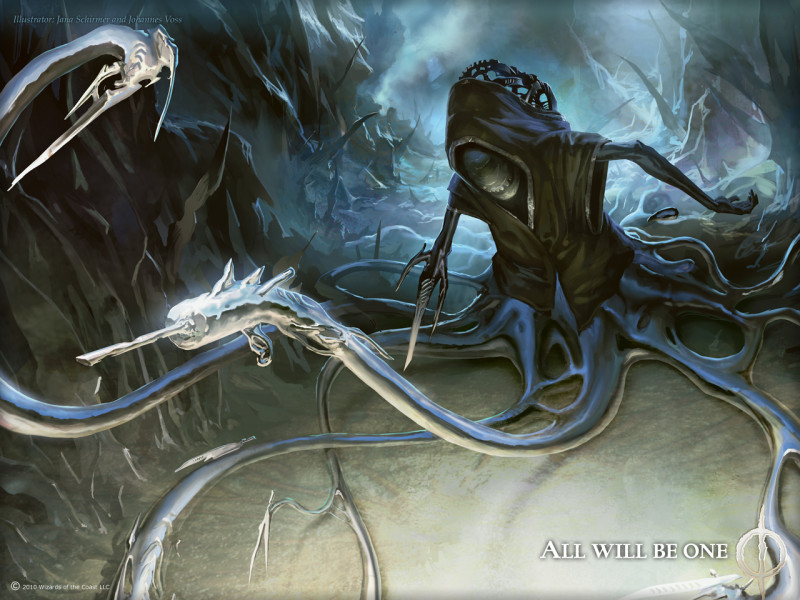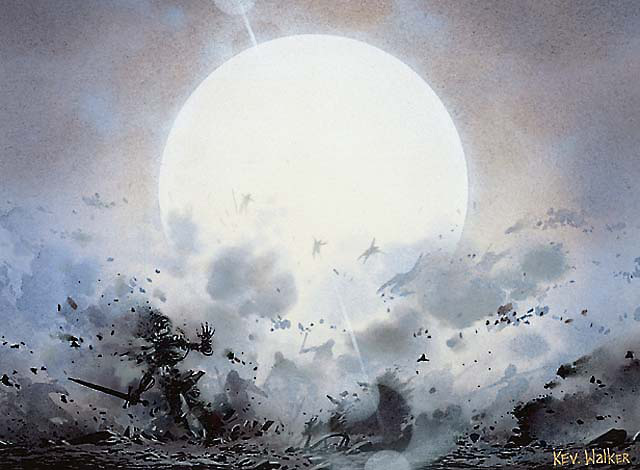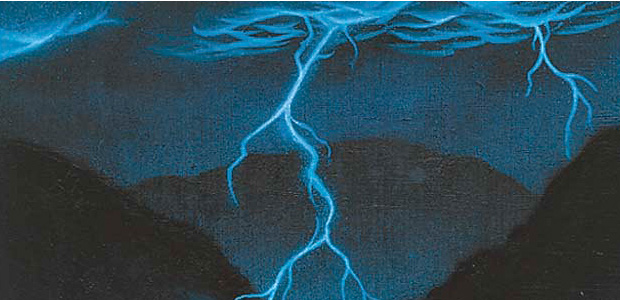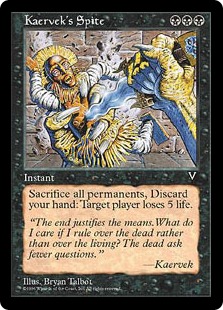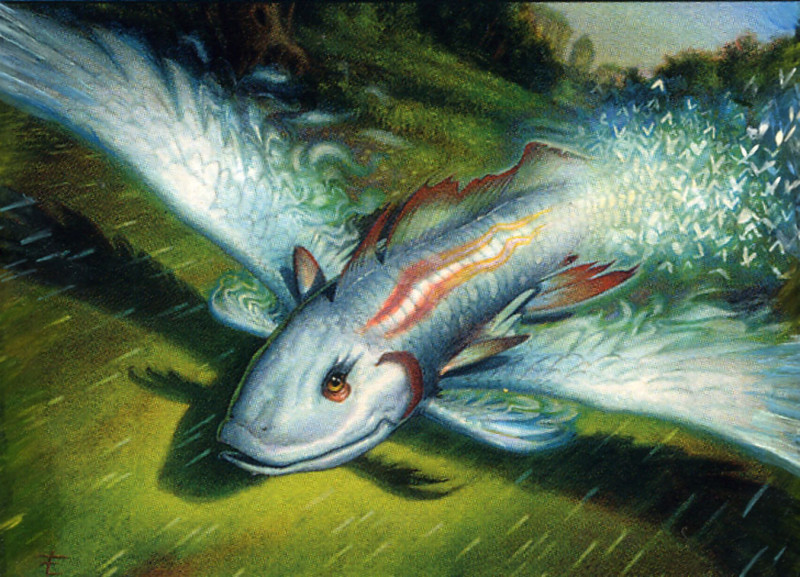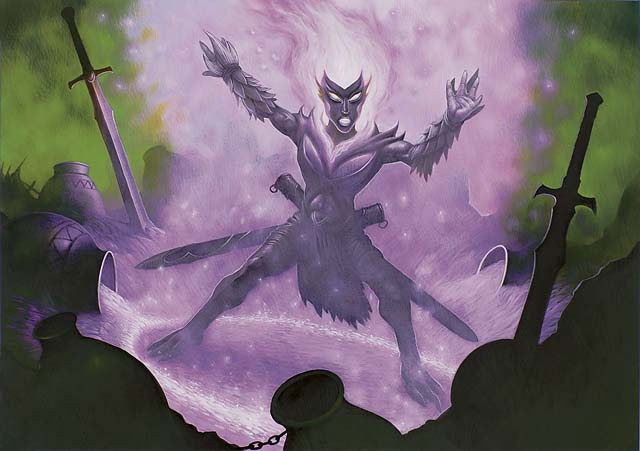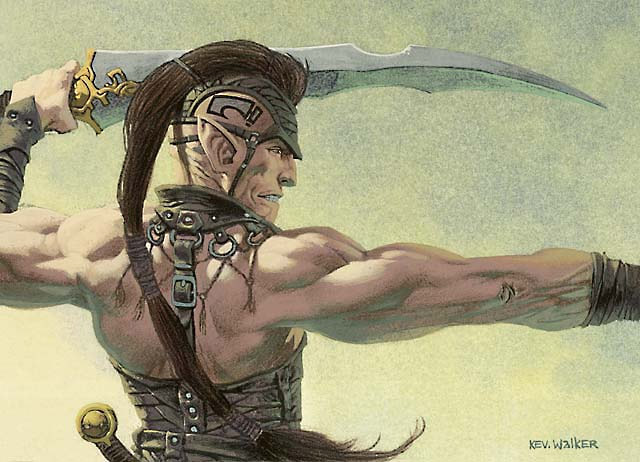Last week, writing at Star City Games, Jim Davis took a break from his normal oeuvre of deckbuilding and tournament practice to write an article about his top eight favorite Magic cards. His article generated plenty of discussion, and after a little thought, I left my own list of eight cards in the comments.
Thinking through those favorite cards brought back a lot of memories, and as I continued to ponder what my own favorite-favoritest Magic cards were, I realized I had more to say. So, inspired by Jim, I’m submitting my own list, with my own thoughts. If you caught my list back in the SCG comments, you’ll note I shifted things around a little—the result of additional reflection, as well as the fact that there are lots more than just eight Magic cards I have deep affection and respect for.
Without further ado:
Honorable Mention: Phyrexian Metamorph
We’ll start with the card I demoted off my original list. Phyrexian Metamorph made my first pass almost exclusively because of Commander. I missed it in its original printing (at the time I was only going to game stores quite rarely), but happened to trade for a year or two later. Since then, it’s wormed its way into a lot of my blue Commander decks.
 The larger number of opponents in a Commander game means a larger number of things to clone, so Metamorph naturally gains in a multiplayer format, not least because unlike most clones, it also copies artifacts. Metamorph is a true Swiss army knife: it’s cheap to cast, copies any big creature, replicates enters-the-battlefield abilities, and its native 0/0 stats mean that lots of effects can pull it back from the graveyard. Being an artifact itself, it benefits from a whole host of synergies—[mtg_card]Sanctum Gargoyle[/mtg_card], [mtg_card]Leonin Abunas[/mtg_card], [mtg_card]Etherium Sculptor[/mtg_card], and the like.
The larger number of opponents in a Commander game means a larger number of things to clone, so Metamorph naturally gains in a multiplayer format, not least because unlike most clones, it also copies artifacts. Metamorph is a true Swiss army knife: it’s cheap to cast, copies any big creature, replicates enters-the-battlefield abilities, and its native 0/0 stats mean that lots of effects can pull it back from the graveyard. Being an artifact itself, it benefits from a whole host of synergies—[mtg_card]Sanctum Gargoyle[/mtg_card], [mtg_card]Leonin Abunas[/mtg_card], [mtg_card]Etherium Sculptor[/mtg_card], and the like.
Phyrexian Metamorph also wins points for being a one of the best implementations of Phyrexian mana. As its reminder text states, although Metamorph it’s a blue card, you can pay life for its blue mana requirement, if you’re so inclined. Phyrexian mana is a clever mechanic which captures the transgressive feel of the Phyrexians, one of Magic‘s first and best villains. Unfortunately, it also creates color-pie-bending or -breaking cards like [mtg_card]Mental Misstep[/mtg_card], [mtg_card]Dismember[/mtg_card], and [mtg_card]Gut Shot[/mtg_card].
Metamorph, on the other hand, feels like it could be just an artifact, if it had to be—it’s not as much copying as artifacts normally get, but cards like [mtg_card]Duplicant[/mtg_card] and [mtg_card]Sculpting Steel[/mtg_card] have played in the space before. For enough mana, in a juiced-up artifacts set, I could see it happening, which preserves the sense of color pie integrity in spite of the Phyrexian mana. (Plus, in Commander, its color identity is blue anyway.)
Still, being abusable in Commander and being a design curiosity wasn’t enough to keep it in my top eight. What did make the cut, then?
8. Ovinomancer
I started playing Magic sometime in fifth grade and hit my stride in middle school. By “hit my stride,” I mean that I understood how to play the game and was familiar with all the rules. My strategic and tactical understanding of the game, on the other hand?
Well, let’s just put this way: I loved Ovinomancer.
 Ovinomancer is not a good Magic card. The tempo setback of returning three (three!) lands to your hand is monstrous. It still has summoning sickness, so you have to wait a turn to use its ability. Returning it to your hand is part of the ability’s cost, so you can’t untap it and use it again before it bounces. And all that is on a fragile 0/1 body.
Ovinomancer is not a good Magic card. The tempo setback of returning three (three!) lands to your hand is monstrous. It still has summoning sickness, so you have to wait a turn to use its ability. Returning it to your hand is part of the ability’s cost, so you can’t untap it and use it again before it bounces. And all that is on a fragile 0/1 body.
Was I doing anything to ameliorate these drawbacks? No. No, I was not.
In my defense, I submit the following: Ovinomancer turns dudes into sheep.
 For me, [mtg_card]Ovinomancer[/mtg_card] represents a set of cards that turned Magic from a game about killing your opponent into a game about doing fun stuff: a little mini-game that let you mess around en route to (hopeful) victory. [mtg_card]Ovinomancer[/mtg_card] made sheep, and sheep were fun. Sheep were cool. Sheep were little 0/1 leftovers that used to be dragons or angels. That made every time he got picked off by [mtg_card]Fireslinger[/mtg_card] or [mtg_card]Prodigal Sorcerer[/mtg_card], every time he got Terrored, every time he cost me so much time I lost anyway, totally worth it.
For me, [mtg_card]Ovinomancer[/mtg_card] represents a set of cards that turned Magic from a game about killing your opponent into a game about doing fun stuff: a little mini-game that let you mess around en route to (hopeful) victory. [mtg_card]Ovinomancer[/mtg_card] made sheep, and sheep were fun. Sheep were cool. Sheep were little 0/1 leftovers that used to be dragons or angels. That made every time he got picked off by [mtg_card]Fireslinger[/mtg_card] or [mtg_card]Prodigal Sorcerer[/mtg_card], every time he got Terrored, every time he cost me so much time I lost anyway, totally worth it.
There were lots of awful cards I loved back then: [mtg_card]Temporal Aperture[/mtg_card], [mtg_card]Phyrexian Portal[/mtg_card], [mtg_card]Petra Sphinx[/mtg_card]. [mtg_card]Ovinomancer[/mtg_card] is by far the worst of the bunch, so it gets the spot on the list.
Baaaaaa.
7. Wrath of God
When I first started playing, I couldn’t figure out why Wrath of God was good, or why everyone wanted to open it, find it, or trade for it. It’s a common thread among new players; I’m pretty sure everyone who has played Magic for any length of time has had this conversation:
“Why would I ever want to cast this? It kills all my creatures.”
“Sure, but you don’t have to have any creatures when you cast it.”
Oh.
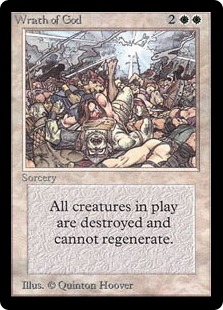 [mtg_card]Wrath of God[/mtg_card] stands alongside cards like [mtg_card]Swords to Plowshares[/mtg_card] (which itself almost made this list) as an exemplar of “learner” cards—cards that appear weak or narrow at first, but whose value becomes clear as you come to better understand the game. Often these cards involve symmetrical effects or side benefits for your opponents. Learning to use them effectively means learning what’s really important in the game, learning to build better decks, learning to plan a strategy and execute it.
[mtg_card]Wrath of God[/mtg_card] stands alongside cards like [mtg_card]Swords to Plowshares[/mtg_card] (which itself almost made this list) as an exemplar of “learner” cards—cards that appear weak or narrow at first, but whose value becomes clear as you come to better understand the game. Often these cards involve symmetrical effects or side benefits for your opponents. Learning to use them effectively means learning what’s really important in the game, learning to build better decks, learning to plan a strategy and execute it.
Beyond that, [mtg_card]Wrath of God[/mtg_card] is a staple effect: there are certain effects Magic just needs to have in the game, and sweepers like Wrath are among them. As will become apparent from the rest of this list, I have a great affection for cards like these: just the right effect, at just the right cost, showing up year after year.
Speaking of year after year, another reason to love [mtg_card]Wrath of God[/mtg_card] is the impact it’s had on the game. Along with the classic [mtg_card]Counterspell[/mtg_card], perhaps no card is so associated with control strategies: counter spells, clear the board, draw cards, and win (eventually). For years the classic matchup of aggressive deck vs. control deck has been defined by the four-mana flashpoint, when the control player could cast [mtg_card]Wrath of God[/mtg_card] and (hopefully) buy enough time to stabilize. It now seems that five mana may be the new standard for wrath effects, as evinced by [mtg_card]End Hostilities[/mtg_card] and [mtg_card]Crux of Fate[/mtg_card]. If that’s the case, it’ll be an interesting new era for Magic.
6. Lightning Bolt
There was never any such confusion for [mtg_card]Lightning Bolt[/mtg_card]. Every Magic player, as soon as they know how to read [mtg_card]Lightning Bolt[/mtg_card], understands that [mtg_card]Lightning Bolt[/mtg_card] is a great card. This is because it’s a simple, elegant removal spell, the historic high-water mark for burn spell efficiency, and the greatest representative of red’s signature strategy. Also, and this is important, because hurling lightning at things is totally fucking awesome.
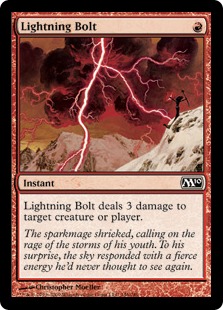 [mtg_card]Lightning Bolt[/mtg_card] is a surprisingly strategic card. Unlike Wrath, the question is not how to use it, but when: newer players tend to spew it at their opponent’s face whenever they draw it; better players hold it almost exclusively for creatures; and the best players can distinguish between the two—sometimes “turn one, Bolt you” is the right play. It’s a testament to Magic as a game that one of the simplest possible cards is also among the most difficult to play perfectly.
[mtg_card]Lightning Bolt[/mtg_card] is a surprisingly strategic card. Unlike Wrath, the question is not how to use it, but when: newer players tend to spew it at their opponent’s face whenever they draw it; better players hold it almost exclusively for creatures; and the best players can distinguish between the two—sometimes “turn one, Bolt you” is the right play. It’s a testament to Magic as a game that one of the simplest possible cards is also among the most difficult to play perfectly.
Even more important, though, is that [mtg_card]Lightning Bolt[/mtg_card] is fun. And that fun never really goes away: there just something visceral about Bolting things. As an almost twenty-year veteran of Magic, having played any number of formats, something that can take me back to my earliest days playing at the kitchen table is special indeed. Magic is a game that’s bigger than the box, but it’s still a game, and games should be fun to play. It’s easy to forget that.
[mtg_card]Lightning Bolt[/mtg_card] also gets special mention as the marquee card for “Kangaroo Court,” a variant my friends either discovered or made up. In Kangaroo Court, you had an actual flavor judge sitting at the table with you, who would allow you to change card mechanics based on their artwork. Since [mtg_card]Lightning Bolt’s[/mtg_card] art (the original Chris Rush art, above) actually shows two bolts of lightning, it was ruled that the spell could target two creatures.
This sure sounds awesome. And, if you’re a creative type, I’d encourage you to try it and let me know how it goes. For fifth-graders, though, it regularly devolved into shouting matches and blatant favoritism, and as an unpopular, conflict-averse child, I got trounced at Kangaroo Court whenever it came up.
It still can’t stop me from loving [mtg_card]Lightning Bolt[/mtg_card], though. Doesn’t everyone?
Visions was one of two sets I tried to put together when I played Magic back in middle school, so it’s no surprise to see two cards from it make this list—I have a lot of fond memories of that set. (The other? Chronicles. In my defense, Chronicles packs were among the cheapest at my local game store, which was very relevant to twelve-year-old me.) Of all the cards and flavor texts I love, [mtg_card]Kaervek’s Spite[/mtg_card] has stuck with me the longest.
Inasmuch as I love cards that are simple, staple effects, I also love cards that are pure expressions of their color’s ideals. By that metric, Kaervek’s Spite is pretty much the baddest, blackest spell on the block. Black is the color that is willing to do whatever it takes for power and for victory. That’s why black is willing to do what other colors won’t: raise zombies, make pacts with demons, sacrifice its own creatures, even siphon off its own life. [mtg_card]Kaervek’s Spite[/mtg_card] is just that: a total sacrifice of everything, a complete debasement of the self: everything you know and love burned to the ground, just to kill your enemies. It’s even got the triple-black casting cost.
While the colors are inherently unaligned, black is the color most often associated with evil, since so many of black’s values line up with what we expect in villains. You can hear echoes of black’s philosophy in all kinds of literature. Voldemort is one of my favorites: “There is no good and no evil; there is only power, and those too weak to seek it.” And fittingly, for [mtg_card]Kaervek’s Spite[/mtg_card]: “I was less than spirit, less than the meanest ghost . . . but still, I was alive.” You’re alive, and your opponent isn’t. That’s a deal black can live with.
[mtg_card]Kaervek’s Spite[/mtg_card] isn’t the most subtle card around—you’d never cast it unless it was going to win you the game, or you were about to lose. But great cards tell stories, and the one [mtg_card]Kaervek’s Spite[/mtg_card] tells is compelling indeed: everything for power, everything for victory. Nothing matters more. That’s as black as it gets.
4. Mulldrifter
In talking about Lightning Bolt, I mentioned that compiling this list made me realize I have a strong affection for simple, staple effects. In particular, I’m fascinated by a few cards that the game just wants—cards that history has shown us are at just the right power level and just the right cost. If you look at card lists, you’ll notice that a few cards have been reprinted again and again over the last few years. Naturalize is one. The other I keep noticing? Divination.
 Divination has become such a staple effect over the last few years that it’s surprising how long it took to design the card at all. The first Magic set, Alpha, actually had only two blue card-drawing spells, both rare: [mtg_card]Braingeyser[/mtg_card] and [mtg_card]Ancestral Recall[/mtg_card]. Most of blue’s card draw in other early sets was either conditional, or part of filter effects—you’d draw a few, but also discard a few. It wasn’t until Visions (again!) that we got [mtg_card]Inspiration[/mtg_card], a simple instant-speed draw two. Years later, [mtg_card]Counsel of the Soratami[/mtg_card] appeared in Champions of Kamigawa. Time has shown since then that two cards for three mana is just the right rate.
Divination has become such a staple effect over the last few years that it’s surprising how long it took to design the card at all. The first Magic set, Alpha, actually had only two blue card-drawing spells, both rare: [mtg_card]Braingeyser[/mtg_card] and [mtg_card]Ancestral Recall[/mtg_card]. Most of blue’s card draw in other early sets was either conditional, or part of filter effects—you’d draw a few, but also discard a few. It wasn’t until Visions (again!) that we got [mtg_card]Inspiration[/mtg_card], a simple instant-speed draw two. Years later, [mtg_card]Counsel of the Soratami[/mtg_card] appeared in Champions of Kamigawa. Time has shown since then that two cards for three mana is just the right rate.
Divination also so perfectly captures blue’s color philosophy: blue is the color that most wants options and knowledge before it acts, sometime at the risk of not acting in time. Spending turn three casting Divination is doing just that: casting a spell that doesn’t affect the board now, in favor of having more options later.
So after this love letter to [mtg_card]Divination[/mtg_card], why do I have [mtg_card]Mulldrifter[/mtg_card] on the list? Well, here I have to nod to the EDH player in me: [mtg_card]Mulldrifter[/mtg_card] is [mtg_card]Divination[/mtg_card] with a whole host of upsides. Evoking [mtg_card]Mulldrifter[/mtg_card] is essentially [mtg_card]Divination[/mtg_card], full stop. [mtg_card]Mulldrifter[/mtg_card] also has a mode that gives you [mtg_card]Divination[/mtg_card] attached to a 2/2 flying creature, and that creature can be blinked, sacrificed, reanimated, equipped, enchanted, and so forth. It’s very skill-testing to decide whether you need cards now, or whether you can wait for full value. So [mtg_card]Mulldrifter[/mtg_card] gets the nod. But it’s the [mtg_card]Divination[/mtg_card] inside that really makes me love it.
3. Oblivion Ring
Like [mtg_card]Divination[/mtg_card], Oblivion Ring (today [mtg_card]Banishing Light[/mtg_card]) is another effect that seems so basic and so clear for its color that it’s surprising it took Magic designers more the ten years to hit on it. In [mtg_card]Oblivion Ring[/mtg_card]’s case, it wasn’t until Lorwyn, in the autumn of 2007. Since then, [mtg_card]Oblivion Ring[/mtg_card] has become so closely associated with white that it’s a staple in most white Commander decks (and often more competitive formats as well). The basic design has been riffed on several times—most notably with [mtg_card]Fiend Hunter[/mtg_card] and [mtg_card]Banisher Priest[/mtg_card]. [mtg_card]Oblivion Ring[/mtg_card] is just a great removal spell. It’s as simple as that.
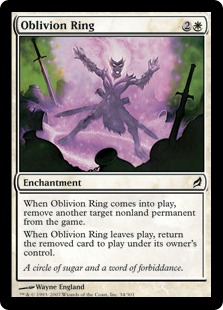 As with [mtg_card]Kaervek’s Spite[/mtg_card] and [mtg_card]Mulldrifter[/mtg_card] (ahem, [mtg_card]Divination[/mtg_card]), I love cards that mechanically express their colors’ philosophies. [mtg_card]Oblivion Ring[/mtg_card] is another great example. It feels like a natural extension of [mtg_card]Pacifism[/mtg_card]. White is the color that desires peace above all, which means it sometimes doesn’t have the teeth to kill. Instead, white banishes. White imprisons. It’s usually the same thing . . . except when what you’re locking away gets out, which is easy to do with a [mtg_card]Naturalize[/mtg_card] or a [mtg_card]Boomerang[/mtg_card].
As with [mtg_card]Kaervek’s Spite[/mtg_card] and [mtg_card]Mulldrifter[/mtg_card] (ahem, [mtg_card]Divination[/mtg_card]), I love cards that mechanically express their colors’ philosophies. [mtg_card]Oblivion Ring[/mtg_card] is another great example. It feels like a natural extension of [mtg_card]Pacifism[/mtg_card]. White is the color that desires peace above all, which means it sometimes doesn’t have the teeth to kill. Instead, white banishes. White imprisons. It’s usually the same thing . . . except when what you’re locking away gets out, which is easy to do with a [mtg_card]Naturalize[/mtg_card] or a [mtg_card]Boomerang[/mtg_card].
White’s got a smattering of spot removal—[mtg_card]Swords to Plowshares[/mtg_card], [mtg_card]Path to Exile[/mtg_card]—but these effects have always resonated more with me. (It doesn’t hurt that white’s philosophies, carried too far, devolve into facism, and imprisonment is fitting flavor for that as well. )
2. Dark Confidant
I got back into Magic after a five-year hiatus with Champions of Kamigawa. By the time Ravnica came out a year later, Magic had swept through my (exceedingly nerdy) college fraternity and had firmly set its hooks in me. I was reading everything I could and playing every chance I got.
[mtg_card]Dark Confidant[/mtg_card], more than any other, was the card of the zeitgeist. The players in my house had varying levels of skill and varying amounts of experience, but it was clear to all of us that Dark Confidant was good. We knew a 2/1 or 2/2 for two mana was a good rate. We knew extra cards were good. We knew that life loss was acceptable, if it led to large enough advantages in other areas of the game. Dark Confidant was something we could look at and say definitively: yes. That’s good.
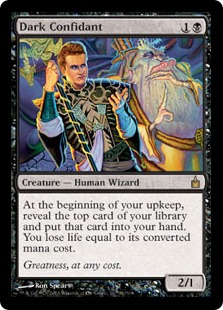 It didn’t hurt that those of us who read articles and tournament coverage saw a lot of people chattering about the card on the internet. It was a $20 card out of the pack (an idea that seems downright quaint now), and in spite of being mediocre in draft, it was the card everyone wanted to open. It was the face of the set. It was an Invitational card, bearing the likeness of Bob Maher (“the Great One”—hence the flavor text), a person whom we’d heard of, but had little context to place.
It didn’t hurt that those of us who read articles and tournament coverage saw a lot of people chattering about the card on the internet. It was a $20 card out of the pack (an idea that seems downright quaint now), and in spite of being mediocre in draft, it was the card everyone wanted to open. It was the face of the set. It was an Invitational card, bearing the likeness of Bob Maher (“the Great One”—hence the flavor text), a person whom we’d heard of, but had little context to place.
In spite of all that, [mtg_card]Dark Confidant[/mtg_card] never really took off in Standard while it was legal. Part of that is because it’s so elegantly balanced: it offers power at any cost, but of course you don’t want to pay too much. Instead, taking advantage of [mtg_card]Dark Confidant[/mtg_card] sets you on a particular deckbuilding path, weeding out high-cost cards that aren’t quite good enough to make the ability safe enough to play. Like the color it represents, [mtg_card]Dark Confidant[/mtg_card] requires commitment. It wants something from you before it gives something to you. That’s easier in formats like Modern, where the larger card pool gives you a better selection of powerful, cheap cards to run. It was less easy in [mtg_card]Dark Confidant[/mtg_card]’s Standard, where people reanimated [mtg_card]Akroma, Angel of Wrath[/mtg_card] on turn three or four.
As with [mtg_card]Oblivion Ring[/mtg_card], it’s surprising to me that an ability that so perfectly captures the philosophy of black took so long to hit upon. But here it is, in a perfectly balanced package: a 2/1 body that can attack, but is easy enough to remove. A 1B casting cost (apparently originally BB) that makes you play black, but offers your choice of colors to pair. And a dangerous, tempting ability, which offers power and greatness. If you’re willing to risk the cost.
1. Llanowar Elves
One of the biggest influences on Magic‘s design was Cosmic Encounter, a game in which players try to maneuver tiny spaceships onto other players’ boards. Each player has a card which allows them to break the game’s basic rules in a fun and interesting way. And there are a lot of these cards, so the game has great replay value.
That basic idea—establish rules, introduce cards that break them—undergirds Magic‘s design. Each card you put in play and each spell you cast lets you do something you couldn’t before, usually by breaking the game’s normal rules. Usually, you draw only one card per turn. [mtg_card]Dark Confidant[/mtg_card] or [mtg_card]Dark Tutelage[/mtg_card] will let you draw more, at a price. Usually, you attack only once, but [mtg_card]Relentless Assault[/mtg_card] might change that for you. Usually, you lose the game when you have 0 life, but something like [mtg_card]Lich[/mtg_card] might keep you around. There is a great pattern of tableau-building play in a lot of Magic—Commander especially—whereby you gradually increase in power as you add more permanents to the board. It’s an intuitive and satisfying way to play.
More and more, rule-bending effects like these are appearing on creatures. Time Spiral block’s magus cycles ([mtg_card]Magus of the Disk[/mtg_card] et al.) featured a number of famous artifacts, enchantments, and lands turned into creatures, and the trend continued with standouts like [mtg_card]Fauna Shaman[/mtg_card], a creature version of [mtg_card]Survival of the Fittest[/mtg_card]. These days, when you want to break the rules and give yourself more abilities, it’s as common to reach for a creature as for an artifact or an enchantment.
Magic’s earliest sets, by contrast, were much more about getting your opponent dead: get those life points down from 20 to 0. Most of the Alpha set’s creatures just attack and block. The ones that have abilities tend to have ones that make them better at attacking or blocking: protection, first strike, regeneration, landwalk, flying. Even flavorful stuff like [mtg_card]Cockatrice[/mtg_card] boils down to “don’t get in a fight with me.”
There are just a few creatures with tap abilities that point towards Magic’s future as we know it today—the game in which your creatures are investments that increase your own abilities as much as they are beatsticks to slap your opponent with. [mtg_card]Nettling Imp[/mtg_card]. [mtg_card]Northern Paladin[/mtg_card]. [mtg_card]Demonic Hordes[/mtg_card]. [mtg_card]Royal Assassin[/mtg_card]. [mtg_card]Dwarven Warriors[/mtg_card].
Of all these, [mtg_card]Llanowar Elves[/mtg_card] takes the cake. It’s the simplest, most elegant execution of a creature whose purpose is to stay in play and give you access to more powerful plays on later turns. It feels like you, the planeswalker, are summoning other able druids to work with you and lend you their magic. And it’s still seeing play today, albeit in its re-flavored [mtg_card]Elvish Mystic[/mtg_card] form. Like Divination, it’s the right effect at the right cost—exactly what the game wants. As an iconic, staple effect, which at Magic‘s earliest days heralded the way we play twenty years later, Llanowar Elves gets my vote for my favorite card—the best card—of all time.
Around the Planes: Over on his blog “Killing a Goldfish,” Jesse Mason has a great interview with Sue Ann Harkey, one of the early art directors for Magic. As Mason’s interview demonstrates, Harkey had a huge influence on Magic art. It’s worth a read if you’re interested in the art and history of the game.
That’s all for this week! Don’t be shy in the comments: let me know what you think of my list, and please feel free to post your own top eight cards!

